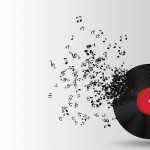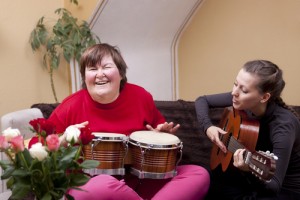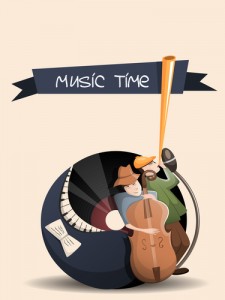
In the Woodland we all enjoy a good sing-a-long, but can this actually be therapeutic?
Music therapy has a growing database with regards to its use in helping to treat a variety of mental health disorders. It is thought of as a systematic intervention that uses music experiences (active or receptive) and the relationships that develop through these to promote health.
In August of this year, Carr and colleagues published a systematic review in PLoS ONE relating to music therapy and it’s use in acute adult psychiatric in-patient units; an area as yet to be looked at.
Methods
Medical, psychological and music therapy databases were searched and papers describing music therapy with acute adult psychiatric in-patients were included.
Carr and colleagues then looked at the following questions:
- What are the clinical aims and considerations for music therapy with acute adult psychiatric patients in acute hospital settings?
- How is music therapy provided in these settings in terms of frequency, duration and methods used?
- What are the findings from outcome studies conducted in these settings?

Fostering therapeutic engagement with patients, or bongo fury as it’s more commonly known on the ward
Papers were included if they described music therapy as the main component of treatment with adult in-patients (ages 18+) admitted for treatment of acute symptoms in psychiatric hospitals. Papers focusing on patients with organic mental illness were excluded.
Data obtained was a mix of quantitative and qualitative outcomes and analysis of this included thematic analysis.
Results
98 papers were included: 57 covered acute work specifically, whilst 41 included acute work as part of a wider discussion of practice in mental health. The majority of papers came from the USA and UK and were clinical theoretical discussions or case studies (N=63), whilst research and service evaluations comprised 35 of the included papers.
Themes of aims:
- Fostering therapeutic engagement with patients
- Building interpersonal relationships in the ‘here and now’ rather than long term insight or understanding
- Immediate effects such as reduction in arousal or relaxation, which were suggested to be of immediate benefit both to individuals and the ward environment as a whole
- Patients within acute settings were noted to be in crises, and interventions therefore focused upon management of symptoms and interpersonal relationships
Themes of delivery:
- Open ward groups were the predominant form of delivery
- Smaller semi-open or closed groups were run to meet specific needs or levels of functioning
Outcomes:
- Reductions in positive and negative symptoms and increased interpersonal functioning were significantly more favourable in patients receiving music therapy compared to controls, although the size of the effects were small
- Outcomes for depression were mixed and not significant
Five papers sought patient evaluations of music therapy, a selection of their results included:
- Music therapy consistently gained the most positive appraisals, and was significantly more pleasurable than other groups
- The benefit is broader than symptomatic change
- Patients rated music therapy positively, particularly in terms of enjoyment, safety, relaxation and improvement in mood
Summary
This review has identified clinical practice spanning 40 years across a range of countries in acute in-patient settings. Despite this large body of work, very little research exists to qualify the evidence base for practice in acute settings
One possible model of music therapy for inpatients may be to offer a high intensity of sessions. An alternative or adjunctive model may be to focus on brief interventions lasting only a few or even a single session although this would require consideration of clinical aims and outcomes that might be possible to achieve in such a short amount of time.
Future research needs to disentangle the processes of music therapy for this population in order to better define indications and the types of outcomes that may be achieved. The consideration of the importance of qualitative research may well be key here – a possible need for a change of direction in evidence based medicine?
Links
Carr C, Odell-Miller H, Priebe S (2013) A Systematic Review of Music Therapy Practice and Outcomes with Acute Adult Psychiatric In-Patients. PLoS ONE 8(8): e70252. doi:10.1371/journal.pone.0070252


Music therapy is a hit with the patients, but not in the results: In the Woodland we all enjoy a good sing-a-l… http://t.co/hLEBIfObNu
@Mental_Elf is that a fair headline? Results according to the blog seemed to be good , particularly in patient appraisals…thanks for blog.
@julesevans77 @Mental_Elf title was supposed to reflect difficulty and lack of quantitative evidence. Qualitative info needs more weight!
@LiaisonLawson @Mental_Elf Fair enough
“@Mental_Elf: Music therapy is a hit with the patients, but not in the results http://t.co/TOX4D5YD7X” depends on ‘result’def@SongintheCity
@LiaisonLawson blogs on a systematic review of music therapy in acute adult psychiatric inpatient units http://t.co/wyqF0bEAao
@Mental_Elf Maybe they’re asking the wrong questions? My #MusicTherapy is dancing and singing to #PINK -won’t cure me but I sure have fun!!
Systematic review highlights the need for more emphasis on qualitative research of music therapy & mental health http://t.co/wyqF0bEAao
@Mental_Elf @RCOMH what do you guys think about this, from @dr_know? http://t.co/wrdFLKFYWE
Music therapy is a hit with the patients, but not in the results – The Mental Elf http://t.co/Q24ZWEIVtC
Read our blog of the @PLOSONE review of music therapy practice & outcomes with acute adult psychiatric inpatients http://t.co/wyqF0bEAao
In case you missed it earlier: Music therapy is a hit with the patients, but not in the results http://t.co/wyqF0bEAao
@Mental_Elf pity we don’t just give pple what they want and sod the results, if pple simply feel better for experiencing it #goodenoughforme
@Mental_Elf “Music is therapy. Music moves people. It connects people in ways that no other medium can. It acts as medicine.”
@Mental_Elf Meds & even therapy was/is a constant change in life; listening to music, one constant to change my life. TY for the info.
Music therapy is a hit with the patients, but not in the results – .http:/ http://t.co/PsUzOzLS04
[…] used on wards, a 2013 review found that from the 35 research papers identified, there was unclear evidence of the therapeutic benefit of these music groups (Carr et al, […]